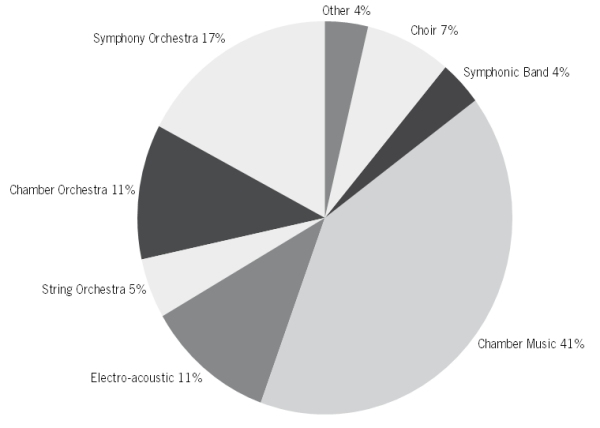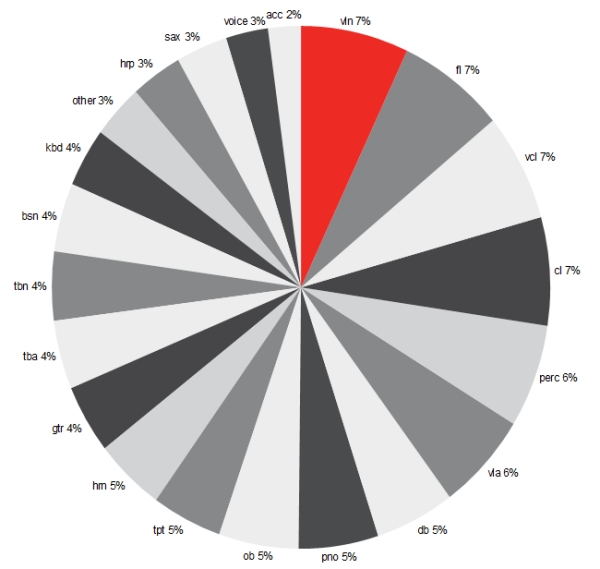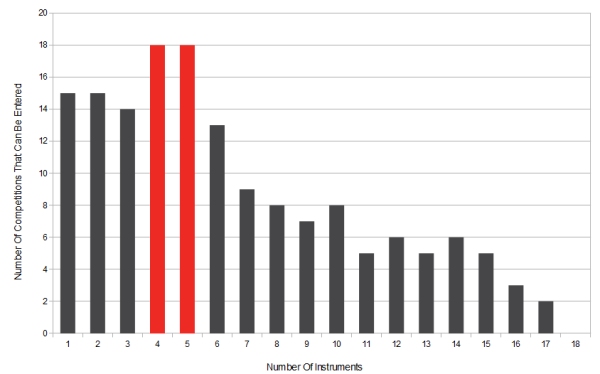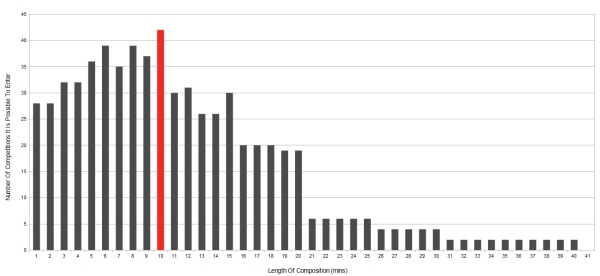Research
ACES_003: Composition Competitions 2010
David Pocknee
The Institute has compiled a list of as many different international competitions for composition that had closing dates between 1 January 2010 and 31 December 2010 in order to assess how lucrative the market is. The research also aimed to uncover patterns in application criteria and the weighting of monetary reward in relation to particular instrumentations.
The data set is presented below.
Data Set: ACES_003: Composition Competitions 2010
Analysis
Duration and Eligibility
From an analysis of this data, some conclusions can be drawn about the optimum length of a composition that will allow it entry into the largest number of competitions. By collating the minimum and maximum possible lengths of compositions, it can be seen that a length of 10 minutes will allow a composition entry into 42 of the 68 competitions surveyed. Also notice the sudden drop in eligibility for compositions over 20 minutes.
| Length Of Composition (mins) | Number of Competitions it is Possible To Enter |
| 1 | 28 |
| 2 | 28 |
| 3 | 32 |
| 4 | 32 |
| 5 | 36 |
| 6 | 39 |
| 7 | 35 |
| 8 | 39 |
| 9 | 37 |
| 10 | 42 |
| 11 | 30 |
| 12 | 31 |
| 13 | 26 |
| 14 | 26 |
| 15 | 30 |
| 16 | 20 |
| 17 | 20 |
| 18 | 20 |
| 19 | 19 |
| 20 | 19 |
| 21 | 6 |
| 22 | 6 |
| 23 | 6 |
| 24 | 6 |
| 25 | 6 |
| 26 | 4 |
| 27 | 4 |
| 28 | 4 |
| 29 | 4 |
| 30 | 4 |
| 31 | 2 |
| 32 | 2 |
| 33 | 2 |
| 34 | 2 |
| 35 | 2 |
| 36 | 2 |
| 37 | 2 |
| 38 | 2 |
| 39 | 2 |
| 40 | 2 |
| 41 | 0 |
Instrumentation And Eligibility
Below is the data broken down by instrumentation. Notice that chamber music is the most eligible for the surveyed competitions.
| Chamber Music | Symphony Orchestra | Chamber Orchestra | Electro-acoustic | Choir | String Orchestra | Symphonic Band | Other |
| 33 | 14 | 9 | 9 | 6 | 4 | 3 | 3 |
Pie chart showing the eligibility of different instrumentations as a proportion of the total number of competitions surveyed:

Due to the large percentage of competitions that chamber music is eligible for and the individual stipulations on instrumentation that often occur within this category, it was then broken down to look at the statistical eligibility of individual instruments. Below, a chart shows the eligibility of individual instruments as a proportion of the total number of chamber music competitions
| Instrument: | acc | voice | sax | hrp | other | kbd | bsn | tbn | tba | gtr | hrn | tpt | ob | pno | db | vla | perc | cl | vcl | fl | vln |
| Amount Of Eligible Camber Music Competitions: | 7 | 9 | 11 | 11 | 11 | 12 | 14 | 14 | 14 | 14 | 15 | 15 | 17 | 17 | 17 | 20 | 21 | 22 | 22 | 23 | 23 |

The chamber music submission guidelines are the most idiosyncratic out of all the competitions surveyed and show large variations in the size of the instrumentation. In order to explore this further, first the most eligible instrumentation size of chamber music was calculated:

However, in order to calculate the most eligible combination of instruments in the chamber music category, this information needed to be cross-referenced with the most eligible individual instruments. Below, the eligibility of instrumentation of between 1 and 7 instruments was calculated using groupings of the top 7 most eligible instruments.

As can be seen, a duo of violin and flute, or a quartet of violin, flute, cello and clarinet, were the most eligible. A piece that uses these instrumentations would be able to enter 11 of the 68 competitions (16 %)
When this data is then added to the most common types of instrumentation, it is possible to see the eligibility of specific chamber music instrumental combinations as a function of the total number of competitions.
The usefulness of this approach, to a composer interested in entering and winning these competitions, is clearly the ability to know how best to distribute their effort. This will allow them, not only to write a piece eligible for the largest number of awards, but also to ensure that as little effort as possible need be expended in the production of a high-eligibility piece without impeding its chances of success.
In the composing of music, a general rule related to the expenditure of energy can be proposed:
That the larger the instrumentation, the more effort will need to be expended in its production, especially in its notation phase. So, an orchestral work will, in most circumstances, require larger expenditures of time and energy, than would a work for solo instrument. (This fact also holds true for the length of a piece - longer pieces involve more work - but we shall get to that in a moment).
The composer who is not only interested in winning competitions but also in the sound allocation of time and effort would want to ensure that the piece they wrote found a balance between its competition eligibility and expenditure of time and effort (a function of the size of instrumentation). To this end, a weighting system may be constructed in which the competition eligibilty of an instrumentation is divided by the size of the instrumentation. The higher this number is, the more efficient the allocation of resources. This weighting can be seen calculated below.
| Instrumentation | Number Of Eligible Competitions | Eligibility Percentage Of Total Competitions | Number Of Players | Effort Weighting (Eligible Competitions/Instrumentation Size) |
| Chamber Music (Total) | 33 | 48.53% | 1-17 | |
| Symphony Orchestra | 14 | 20.59% | 70-100 | 0.2 |
| Chamber Music: vln,fl | 11 | 16.18% | 2 | 5.5 |
| Chamber Music: vln,fl,vcl,cl | 11 | 16.18% | 4 | 2.75 |
| Chamber Music: vln,fl,cl | 10 | 14.71% | 3 | 3.3333333333 |
| Chamber Music: vln,fl,vcl,cl,perc | 10 | 14.71% | 5 | 2 |
| Chamber Orchestra | 9 | 13.24% | 12-20 | 0.75 |
| Electro-acoustic | 9 | 13.24% | - | - |
| Chamber Music: vln,fl,vcl,cl,perc,vla | 9 | 13.24% | 6 | 1.5 |
| Chamber Music: vln | 8 | 11.76% | 1 | 8 |
| Chamber Music: vln,fl,vcl,cl,perc,vla,db | 7 | 10.29% | 7 | 1 |
| Choir | 6 | 8.82% | 16-32 | 0.375 |
| String Orchestra | 4 | 5.88% | 14-17 | 0.2857142857 |
| Symphonic Band | 3 | 4.41% | 37-40 | 0.0810810811 |
| Other | 3 | 4.41% | - | - |
If the instrumentations were then arranged by "Effort Weighting", we can then see the most efficient allocation of time and effort that maximizes possible competition wins, whilst ensuring the smallest possible expenditure of energy. This can be seen below. However, there are some problems with this weighting system, as it supposes that the amount of effort increases linearly in relation to the size of ensemble. Further research would be needed in order to verify this point and it is recommended that any composers following the advice of this paper should take their own work process into account, perhaps even coming up with their own system of weighting. The current weighting system may be most problematic when dealing with the relationship between the top two entries in the table below.
| Instrumentation | Number Of Eligible Competitions | Eligibility as Percentage Of Total Competitions | Number Of Players | Effort Weighting |
| Chamber Music: vln | 8 | 11.76% | 1 | 8 |
| Chamber Music: vln,fl | 11 | 16.18% | 2 | 5.5 |
| Chamber Music: vln,fl,cl | 10 | 14.71% | 3 | 3.3333333333 |
| Chamber Music: vln,fl,vcl,cl | 11 | 16.18% | 4 | 2.75 |
| Chamber Music: vln,fl,vcl,cl,perc | 10 | 14.71% | 5 | 2 |
| Chamber Music: vln,fl,vcl,cl,perc,vla | 9 | 13.24% | 6 | 1.5 |
| Chamber Music: vln,fl,vcl,cl,perc,vla,db | 7 | 10.29% | 7 | 1 |
| Chamber Orchestra | 9 | 13.24% | 12-20 | 0.75 |
| Choir | 6 | 8.82% | 16-32 | 0.375 |
| String Orchestra | 4 | 5.88% | 14-17 | 0.2857142857 |
| Symphony Orchestra | 14 | 20.59% | 70-100 | 0.2 |
| Symphonic Band | 3 | 4.41% | 37-40 | 0.0810810811 |
The Temporal Domain
In order to fully understand the best allocation of effort, the data on instrumentation and time must be cross-referenced. Using the instrumentation and temporal data in isolation, as we have been doing, leaves us open to the possibility that a particular type of instrumentation might come with a recurring set of temporal eligibility criteria that may skew our data. However, the information we have gained so far can help orient our cross-referencing. in order to reduce the large number of instrumental and temporal combinations, We shall use only the most eligible temporal and chamber music instrumentations as the basis for the cross-referencing. Only temporal eligibily between 1-18 minutes, all large competition categories, and an exhaustive set of combinations of the top four most eligible chamber music instumentations will be used.Tne chart below cross-references the instrumental eligibility of the main categories discussed earlier, as well as combinations of the four most eligible instruments in the chamber ensemble category with temporal eligibility, showing for each instrumentation category the amount of competitions which would accept a piece of that length and instrumentation. The results are quite surprising.
Chart Showing Duration of Piece/Instrumentation/Competition Eligibility
| Instrumentation / Duration | 1 | 2 | 3 | 4 | 5 | 6 | 7 | 8 | 9 | 10 | 11 | 12 | 13 | 14 | 15 | 16 | 17 | 18 | TOTAL |
| Symphony Orchestra | 5 | 5 | 6 | 6 | 6 | 6 | 5 | 5 | 5 | 7 | 6 | 6 | 5 | 5 | 6 | 5 | 5 | 5 | 99 |
| Chamber Orchestra | 4 | 4 | 4 | 4 | 4 | 5 | 5 | 6 | 6 | 6 | 5 | 5 | 4 | 4 | 5 | 2 | 2 | 2 | 77 |
| String Orchestra | 1 | 1 | 2 | 2 | 2 | 2 | 2 | 2 | 2 | 2 | 1 | 2 | 1 | 1 | 1 | 1 | 1 | 1 | 27 |
| Choir | 2 | 2 | 3 | 3 | 4 | 5 | 5 | 5 | 5 | 5 | 3 | 3 | 2 | 2 | 2 | 1 | 1 | 1 | 54 |
| Symphony Band | 1 | 1 | 1 | 1 | 1 | 1 | 1 | 1 | 1 | 2 | 2 | 2 | 1 | 1 | 2 | 2 | 2 | 2 | 25 |
| Violin | 4 | 4 | 5 | 5 | 6 | 6 | 6 | 5 | 5 | 5 | 4 | 4 | 4 | 4 | 4 | 3 | 3 | 3 | 80 |
| Flute | 4 | 4 | 5 | 5 | 7 | 7 | 7 | 6 | 5 | 5 | 4 | 4 | 4 | 4 | 4 | 3 | 3 | 3 | 84 |
| Cello | 4 | 4 | 5 | 5 | 6 | 6 | 6 | 5 | 5 | 5 | 4 | 5 | 5 | 5 | 5 | 4 | 4 | 4 | 87 |
| Clarinet | 4 | 4 | 5 | 5 | 6 | 6 | 6 | 5 | 5 | 5 | 4 | 4 | 4 | 4 | 4 | 3 | 3 | 3 | 80 |
| Flute/Violin | 6 | 6 | 7 | 7 | 8 | 8 | 8 | 7 | 7 | 7 | 6 | 6 | 5 | 5 | 5 | 3 | 3 | 3 | 107 |
| Flute/Cello | 6 | 6 | 7 | 7 | 8 | 8 | 8 | 7 | 7 | 7 | 6 | 6 | 5 | 5 | 5 | 3 | 3 | 3 | 107 |
| Flute/Clarinet | 6 | 6 | 7 | 7 | 8 | 8 | 8 | 7 | 7 | 7 | 6 | 6 | 5 | 5 | 5 | 3 | 3 | 3 | 107 |
| Violin/Cello | 6 | 6 | 7 | 7 | 8 | 8 | 8 | 7 | 7 | 7 | 6 | 6 | 5 | 5 | 5 | 3 | 3 | 3 | 107 |
| Violin/Clarinet | 6 | 6 | 7 | 7 | 8 | 8 | 8 | 7 | 7 | 7 | 6 | 6 | 5 | 5 | 5 | 3 | 3 | 3 | 107 |
| Clarinet/Cello | 6 | 6 | 7 | 7 | 8 | 8 | 8 | 7 | 7 | 7 | 6 | 6 | 5 | 5 | 5 | 3 | 3 | 3 | 107 |
| Violin/Flute/Cello | 6 | 6 | 7 | 7 | 7 | 7 | 7 | 6 | 6 | 6 | 5 | 5 | 4 | 4 | 4 | 2 | 2 | 2 | 93 |
| Violin/Flute/Clarinet | 6 | 6 | 7 | 7 | 7 | 7 | 7 | 6 | 6 | 6 | 5 | 5 | 4 | 4 | 4 | 2 | 2 | 2 | 93 |
| Violin/Cello/Clarinet | 6 | 6 | 7 | 7 | 7 | 7 | 7 | 6 | 6 | 6 | 5 | 5 | 4 | 4 | 4 | 2 | 2 | 2 | 93 |
| Flute/Cello/Clarinet | 6 | 6 | 7 | 7 | 7 | 7 | 7 | 6 | 6 | 6 | 5 | 5 | 4 | 4 | 4 | 2 | 2 | 2 | 93 |
| Violin/Flute/Cello/Clarinet | 6 | 6 | 7 | 7 | 7 | 7 | 7 | 6 | 6 | 7 | 6 | 6 | 5 | 5 | 5 | 2 | 2 | 2 | 99 |
This data shows that, for the 68 competitions surveyed in 2010, a duet lasting 5-7 minutes between any combination of flute, violin, clarinet and cello is eligible for the most competitions (8). Other high-eligibility pieces include a 10 minute piece for symphony orchestra (7), a 3-7 minute piece for any 3 or 4 member combination of violin, flute, cello and clarinet (7), a 10 minute quartet for the same ensemble (7), and a 5-7 minute solo flute piece.
Conclusion
Although this research was conducted using data from three years ago, anecdotal evidence suggests that the profile and entry requirements for composition competitions have not changed much in the intervening years. Given the results of this research, the author recommends that composers interested in increasing the possibility of winning competitions by submitting a large amount of entries, produce pieces with the durations and instrumentations listed below.
| Instrumentation | Duration (mins) |
| Flute/Violin | 5-7 |
| Flute/Cello | 5-7 |
| Flute/Clarinet | 5-7 |
| Violin/Cello | 5-7 |
| Violin/Clarinet | 5-7 |
| Clarinet/Cello | 5-7 |
| Solo Flute | 5-7 |
| Violin/Flute/Cello | 3-7 |
| Violin/Flute/Clarinet | 3-7 |
| Violin/Cello/Clarinet | 3-7 |
| Flute/Cello/Clarinet | 3-7 |
| Violin/Flute/Cello/clarinet | 3-7 |
| Violin/Flute/Cello | 3-4 & 8-10 |
| Violin/Flute/Clarinet | 3-4 & 8-10 |
| Violin/Cello/Clarinet | 3-4 & 8-10 |
| Flute/Cello/Clarinet | 3-4 & 8-10 |
| Violin/Flute/Cello/Clarinet | 10 |
| Symphony Orchestra | 10 |
The effort of producing these pieces could then be weighed against a new type of effort weighting that takes into account the relationship of effort to the length of the piece.
Effort Weighting = (Minimum Duration x NUmber Of Instruments) / Number Of Competitions
This would give the following table:
| Instrumentation | Duration (mins) | Minimum Duration | Number Of Eligibile Competitions | Instrumentation Size | Effort Weighting |
| Solo Flute | 5-7 | 5 | 7 | 1 | 1.40 |
| Flute/Violin | 5-7 | 5 | 8 | 2 | 0.80 |
| Flute/Cello | 5-7 | 5 | 8 | 2 | 0.80 |
| Flute/Clarinet | 5-7 | 5 | 8 | 2 | 0.80 |
| Violin/Cello | 5-7 | 5 | 8 | 2 | 0.80 |
| Violin/Clarinet | 5-7 | 5 | 8 | 2 | 0.80 |
| Clarinet/Cello | 5-7 | 5 | 8 | 2 | 0.80 |
| Violin/Flute/Cello | 3-7 | 3 | 7 | 3 | 0.78 |
| Violin/Flute/Clarinet | 3-7 | 3 | 7 | 3 | 0.78 |
| Violin/Cello/Clarinet | 3-7 | 3 | 7 | 3 | 0.78 |
| Flute/Cello/Clarinet | 3-7 | 3 | 7 | 3 | 0.78 |
| Violin/Flute/Cello | 3-4 | 3 | 7 | 3 | 0.78 |
| Violin/Flute/Clarinet | 3-4 | 3 | 7 | 3 | 0.78 |
| Violin/Cello/Clarinet | 3-4 | 3 | 7 | 3 | 0.78 |
| Flute/Cello/Clarinet | 3-4 | 3 | 7 | 3 | 0.78 |
| Violin/Flute/Cello/clarinet | 3-7 | 3 | 7 | 4 | 0.58 |
| Violin/Flute/Cello | 8-10 | 8 | 7 | 3 | 0.29 |
| Violin/Flute/Clarinet | 8-10 | 8 | 7 | 3 | 0.29 |
| Violin/Cello/Clarinet | 8-10 | 8 | 7 | 3 | 0.29 |
| Flute/Cello/Clarinet | 8-10 | 8 | 7 | 3 | 0.29 |
| Violin/Flute/Cello/Clarinet | 10 | 10 | 7 | 4 | 0.18 |
| Symphony Orchestra | 10 | 10 | 7 | 70 | 0.01 |
Further research may involve using time and motion studies as a way of improving the current weighting system. However, one must always remember that this weighting system is based entirely on old modes of production. With the revolutions in production that are currently happening in the creative industries (see the The New Fordist Organization) soon these large exertions of effort in the production of competition-winning compositions may be a thing of the past and a composer will be able to produce, with minimal time and effort, enough works to enter every competition in a given year.

